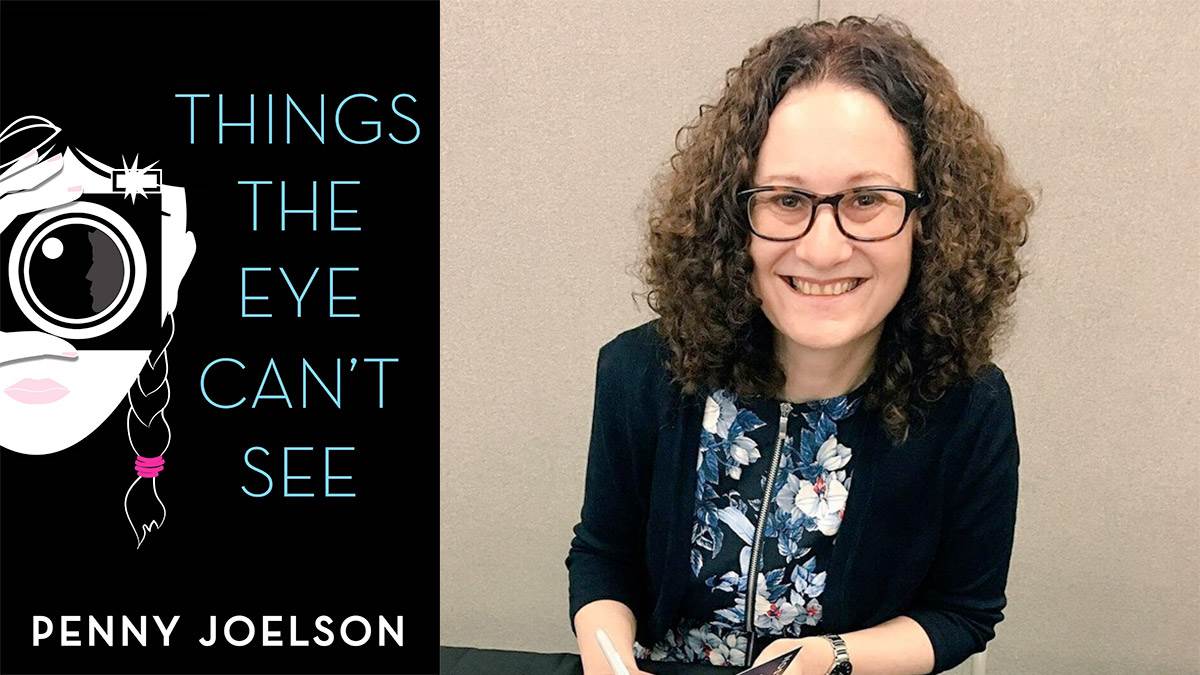Top 10 things to know about visual impairment, by author Penny Joelson
Published on: 5 Hydref 2020
From busting myths to assumption-avoiding tips, Things The Eye Can't See author Penny Joelson shares her top 10 things to know about visual impairment.

In Things the Eye Can't See we meet Libby, a blind girl with a passion for photography, who becomes embroiled in a mystery involving a missing boy. Along the way, the book subtly challenges numerous preconceptions about blindness.
In the month of World Sight Day, BookTrust's Alex Strick asks author Penny Joelson to share some of what she learned during her in-depth research for the book. Here are her top 10 myth-busting facts and assumption-avoiding tips...
1. Someone who is blind can't see anything, right?
Wrong! In fact, only a small percentage of blind people have no sight at all. In the book, Libby can see clearly two centimetres in front of her eyes, but at a greater distance she only sees blurry shapes.
2. So there are many different degrees of visual impairment?
Too right - and I wanted to reflect this, so in the book we meet another girl who has been losing her sight in one eye. Her feelings about sight impairment are very different from those of Libby, who has never known anything different.
3. Libby loves photography and painting – how likely is this outside a work of fiction?
Actually, it's based on real experience. The idea for Things the Eye Can't See was inspired by meeting Emily Davidson, a guide dog owner and Inclusion Ambassador, who is a very talented photographer. In the book, we see Libby use things like a macro lens and a magnifier.
4. Enjoying reading must be a challenge, though?
Emily loves books, despite sometimes getting strange looks when she's in bookshops with her guide dog. She can read text if holding it very close, and she also enlarges text on a screen.
In the book, Libby can do this but finds it tiring to do it for too long so has learnt braille and enjoys audiobooks too. I visited the Braille Library at New College Worcester and discovered an average book translated into braille can take up five or six thick A4 volumes!
5. So how can I help a blind person when they need it?
For starters, don't assume that they do need help. That can be really irritating. One blind person told me about being dragged across a road they didn't want to cross - without even being asked first.
If you think someone may need help, approach and speak to them, touching their shoulder or arm gently to get their attention if need be. Then if they do want your assistance, guide their hand so that they can hold your arm, just above the elbow. Never pull them.
6. Why would a blind person want to go to the cinema?
To enjoy the film! Some of Libby's friends decide not to tell her when they plan a cinema trip, as they assume she wouldn't be able to enjoy it. This happened to a girl I talked to at a mainstream school, but cinemas have headphones and audio description for visually impaired people.
Four New College Worcester students told me about their recent experience at the cinema. They had all needed headphones and audio-description but the cinema didn't anticipate a group ever needing all of these at once and didn't have enough.
7. Someone walking with a guide dog and looking at a mobile phone must surely be faking their disability?
No. Libby encounters some unpleasant people who jump to the assumption that she is faking blindness when she uses her phone to text, but actually she uses Voiceover which translates her voice into text and reads out incoming messages to her. She can also zoom in to read text.
This is a common misunderstanding that I came across while following posts by blind people on Twitter for research.
8. Presumably you should avoid using terms like 'look' and 'you see' when talking to someone who is blind, as that could be insensitive?
Blind people generally don't mind at all and will often use these phrases themselves. Again - don't assume.
9. Guide Dog or Cane?
This is a personal choice, and there can also be long waits for a guide dog. At Redbridge Guide Dog Training Centre, I went out with dogs being trained and learnt how a suitable dog is chosen. A person needs one that has the right walking pace for them, for example, and that suits their personality and lifestyle.
A guide dog is a companion and there is often a powerful bond between dog and owner, but it also needs a lot of care. Some people feel more in control with a cane and it doesn't need feeding or exercise! But with a cane a person only knows the obstacle is there when the cane hits it. A dog will see ahead and move round the obstacle, and is also trained to see higher obstacles like low tree branches that a cane would miss.
10. Can I stroke a guide dog?
Guide dogs are working and need to concentrate so always ask the owner first before petting or calling the dog. People sometimes talk to the dog instead of the owner - even trying to give it directions! Guide dogs don't understand a stream of instructions, only one at a time.
In the book, a child in McDonald's assumes Libby's guide dog Samson will order the food. Though funny, this is more common than you might think - and not just from children!
Topics: Bookmark, Disability, Visual impairment, Features






Add a comment